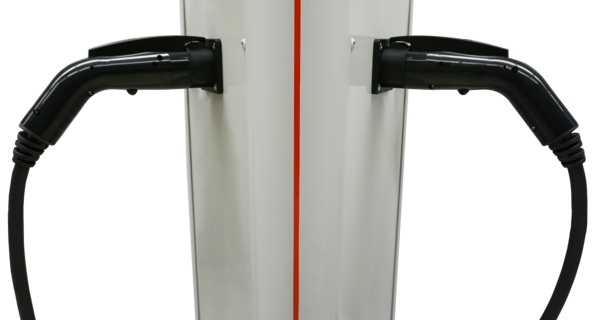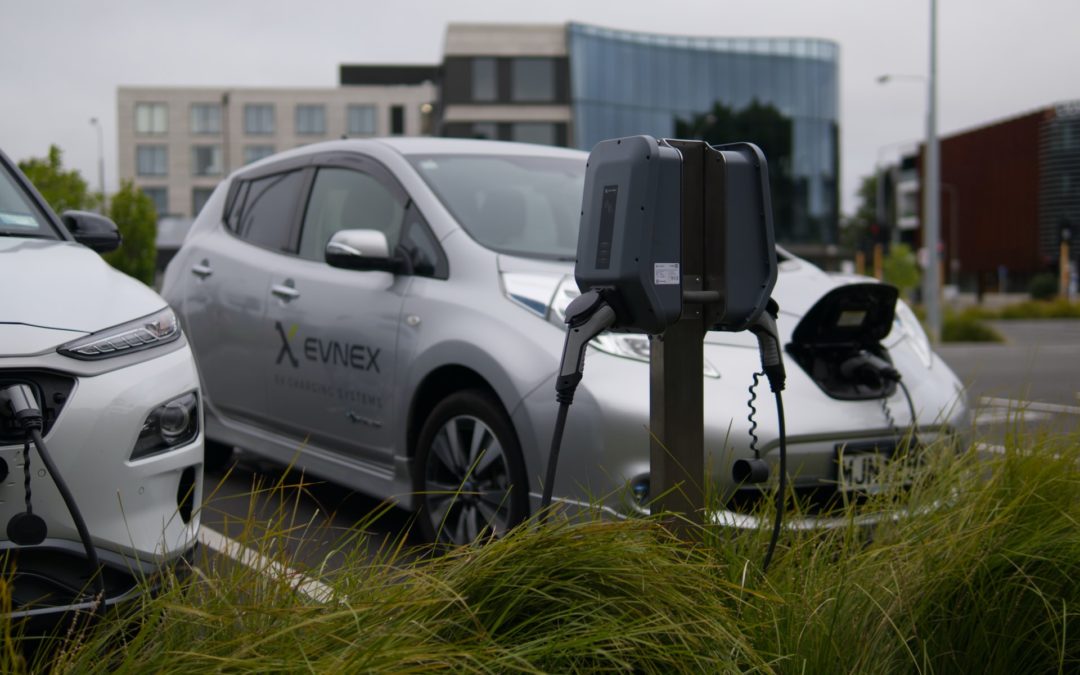Investment in sustainable climate solutions is higher than ever and the mass market for electric vehicles (EVs) is poised to take off. Many consumers are interested in shopping for an electric vehicle but have logistical questions about how EVs work, specifically how they charge. Check out this guide to learn all about the different types of charging stations for electric vehicles and what charging solutions are available for your desired vehicle.
Whether you’re shopping for a personal EV for family use, or considering investing in electric vehicles for your business, there are a variety of charging options available to you. In this electric vehicle charging guide, we’ll cover the most popular charging locations and the three different Levels of charging power available to EV drivers.

Electric Vehicle Home Charging Stations
According to the US Department of Energy, over 80 percent of EV charging happens at home, where EV owners have set up their own chargers. This is likely because home charging is convenient and can often be less expensive than utilizing a public charging station.
So, how does at-home charging work? There are a couple of options:
- Level 1 charging: This charging option operates on a 120-volt household current and will give the driver about three miles of range per hour of charge. Level 1 equipment comes with the electric vehicle when you purchase it, at no extra cost. It requires no additional cost for installation, as long as a power outlet on a dedicated branch circuit is available near the parking location. Most homeowners have one right in their garage!
This charging format is super simple. Just plug one end of the charging cable that came included with your EV into your standard 120V outlet and plug the other end directly into your electric car.
Level 1 charging can typically charge 60 to 80 miles in 20 hours. For this reason, most EV owners utilizing Level 1 charging make it a habit to charge overnight. This works on a day-to-day basis for many electric vehicle drivers that commute locally to work and school, etc.
- Level 2 charging: Level 2 is a step up from Level 1 in several ways. First, it needs 220 volts (technically 208-240 volts) to operate. A wide range of charging speeds are available within Level 2, based on the output current. Typical current outputs are between 16 and 80 amp output, although anything more than 48 amps is generally commercial size such as trucks, school buses, etc.
Just a heads up, Level 2 car chargers generally do not come with your electric vehicle, although a few are starting to include a 120v/240v combination portable charge cable. They are sold separately and prices vary, but they are often purchased at the same time. Slightly more complicated setup, Level 2 chargers are plugged into a 240V outlet and usually mount on an interior or exterior of a garage wall.
However, the higher Level 2 voltage allows charging three to seven times faster depending on the electric car and the charger! Ask a BizReps team member about the benefits of a PowerCharge Level 2 charging station today!
Related Article: HEV vs BEV vs PHEV: Which Electric Vehicle Type Is Better?
Pros and Cons of Level 1 and Level 2 Charging Stations
The biggest advantage of Level 1 chargers is that they are free and ready to use immediately. Because they are provided with your electric car purchase, you don’t have to spend extra money on equipment or time researching the best products.
Level 1 chargers are also ready to use as soon as you get home. They don’t need any special setup or electrical work. As an added benefit, they are portable! You can take them to work if you anticipate needing more charge, or take them out on a road trip vacation. Just pop the charging cable in the trunk of your electric car and go!
There are a few drawbacks to Level 1 charging stations. For starters, their charging time is slow compared to Level 2 charging stations. This is not the best charging solution for procrastinators or drivers who need to pick up and go at the drop of a hat.
Their max power is approximately 1.9 kW, and it would take about 31 hours for a standard 60kW EV battery with a Level 1 charge to be fully charged. So if time is of the essence, this would be a problem! If you are in an apartment complex or somewhere that doesn’t have access to a 120v outlet, you may need to charge at other places throughout the day, such as your workplace.
Level 2 chargers are significantly faster, which is their main benefit over Level 1. A Level 2 charger can charge an electric car up to 7 times faster for a full-electric car or about 3 times faster for a plug-in hybrid! It takes around 5.5 hours to fully charge a 60kW EV battery with an 11 kW charger, and just 1.8 hours with an 11kW charger for 100 miles which is ideal for those who have limited time and need to charge quickly.
Some advanced Level 2 charges, like the PowerCharge™ Pro-Lightning Level 2 commercial charging station, have added bonus smart features such as data collection, user interface systems, enhanced displays, and charging timers.
The main drawbacks of a Level 2 charging station are that it requires proper installation by a professional electrician and a permanent wall mount. This means you won’t really be able to drive it immediately after purchase as it will require some special setup.
There are portable Level 2 chargers on the market. These can be used at home (with a professionally installed 240v receptacle) or used in paces with a matching receptacle, like an RV Park. However, 240v plugs come in many variations and are not commonly available for public use so do your homework if you are planning on using this away from home.
Key takeaways:
- Level 1 or 2 charging at home is convenient and inexpensive.
- Charging at home is safe and secure.
- Both Level 1 and 2 charging stations come waterproof with standard safety features
Related Article: How Long Does It Take to Charge an Electric Vehicle Battery?

Electric Vehicle Public Charging Stations
What’s an EV driver to do if they’re out on the road and running out of charge? What’s the “gas station” for electric vehicles and where can you find one?
Public charging stations are the equivalent of gas stations for electric car drivers. They allow EV drivers to charge their electric cars on the road when they need to travel longer distances than allowed by their EV’s autonomy. These public chargers are often located near populated commercial centers like restaurants, shopping centers, and parking spots.
If you’re low on gas you can quickly locate the nearest gas station using google maps or another app. The same is true for an electric vehicle charging port. Using an app like ChargeHub allows you to find and map every public charger in the USA, make itineraries, and more.
Public charging stations have different levels of charging, connectors, and charging networks. Level 1 and 2 charging, previously covered above in-home charging, are widely available in public charging stations as well. However, a driver could spend 5-20 hours at a public charging station (depending on their make and model, and amount of charge desired) which is no small stop.
Related Article: When Is the Best Time to Charge Electric Vehicles?
A public station may be equipped with Level 3, also known as DC Fast Charger (DCFC). Here’s the scoop on this advanced Level of charging:
- DCFC/Level 3 bypasses the onboard battery charger to put the charge directly into the battery.
- All plugin vehicles are capable of Levels 1 and 2 charging, but generally speaking, only Battery Electric Vehicles (BEV) are capable of DCFC.
- A DC fast charging station is operating as the battery charger by converting AC current into DC current.
- Designated in kWh, the typical Level 3 range is 25-350 kW.
- The electric vehicle will dictate what amount of power it will accept.
- 25 kW = ~100 miles of range per charge (scaling power/range output)
- Vehicles and chargers use a standard communications protocol designed to charge at full speed up to 80% then throttle down at a much lower rate for the remaining 20% to protect against overheating. This safety feature is built into the batteries.
Public DC fast-charging stations also feature three different connectors:
- Tesla: Uses the same proprietary connector for both Level 2 and Level 3 charging.
- J1772/CCS1: Combination plug with two extra plugs for the high-Level charging stations
- ChAdeMo: Nissan and Mitsubishi are the only manufacturers still using a ChAdeMo, and they have announced their transition to CCS1 in North America. Many of the DC fast-charging stations have two connectors to fit your charging needs.
It is critically important to know if your vehicle is compatible with the connectors available before driving to a charging station! This is especially true for non-Tesla DCFC stations. Some stations may have just an SAE Combo CCS connector or CHAdeMO connector, and others will have both.
But you don’t want to roll the dice when your EV is low on charge. Also, many vehicles are not compatible with Level 3 stations. Bottom line: make sure you know your vehicle compatibilities before hitting the road!
Want to learn more about the fastest and most efficient Electric Vehicle charging stations on the market? Contact a BizReps team member today!

